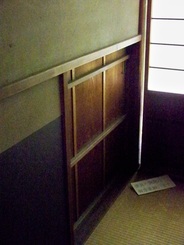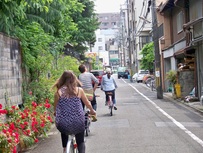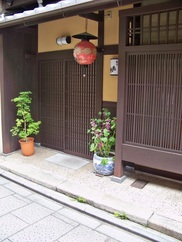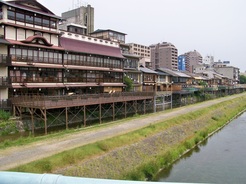June 2, 2012
Kyoto
On our last stop of today’s bike tour, my group was shown a well-preserved tearoom of a typical Kyoto style townhouse, (Kyo-Machiya). The room was dimly lit, contained tatami mats, a traditional alcove, and had windows looking out onto the inner garden. Our guide, Tomo, pointed out a tiny doorway in the side wall, no more than three or four feet high and explained that when this house was an active residence, guests coming to tea would enter through this side door. The doors height restriction provided a physical obstacle that demanded each person entering to do so on their knees bowing, regardless of rank, men, women, and samurai would enter and be served equally; what was important was the ceremony itself and the respite it provided. This seemed wholly relevant on a day where we had all put down our respective titles, cameraman, architect, planner, or student, and observed Kyoto on equal footing. Bicycles.
Bicycles were the vehicle by which we had all been equalized and forced to take in the street activities and built environment of Kyoto without notepads or cameras. I believe it is safe to say that for all of us this was an extremely freeing and rewarding exercise. In the brief walk from Kyoto main station to our Ryokan the night before and this morning’s walk to the bike store I had already felt the pace in Kyoto to be more informal than that of Tokyo, but once I was on a bike the rhythm of the streets felt altogether new. We followed a guide but the act of navigating a foreign city on two wheels forces you to take in paths and landmarks differently than walking. Your connection to where you started from seems stronger than when you surface from a subway stop and set out into the streets, also your choice of paths is more strongly determined by physical limitations than by the indecision or confusion that typically motivates a foreigner exploring a new city on foot.
The first stop on our tour was the Higashi Honganji Temple. Originally built in 1602, the temple was destroyed in a fire and was rebuilt in the 19th century to celebrate the Amida Buddha. We were not able to enter the gate of the temple as it was being repaired but our guide, Tomo, used Higashi Honganji as a backdrop for a brief lecture on traditional Kyoto architecture and building styles. It was here, across from the temple’s gate, next to a lotus fountain, that we were taught about the varying types of latticework seen on Kyotos’s house fronts and what they signified. Different patterns indicated what business existed within; cloth dyers, cloth weavers, charcoal merchants, and tea houses all having specific patterns. We were able to see examples of this biking through the flower towns of Gion and Miyagawacho. Tomo pointed out that although the latticework varied from building to building, patterns of lanterns and rattan blinds were uniform and unique to each flower town.
We moved on to explore Kyoto’s rivers, bridges and canals. The Kamogawa River dissects the eastern portion of Kyoto, providing an expansive improvised public space along the rivers edge and along its overpasses. Another waterway is the Takase River, a canal that was used for transporting goods from 1614 to 1920. The goods were moved along the shallow canal on flat-bottomed Takasebune boats. The Tatsumi Bridge and shrine were two more picturesque stops along our route. It was surprising how clear the waterways were and how many fish we saw in them.
After the tour was over, many of us held on to our bikes to further explore Kyoto late into the afternoon, visiting food markets, temples, and museums. In the evening we met for Kaiseki; a Kyoto cuisine-tasting menu. All nineteen of us sat on tatami mats and worked our way through course after delicious course of vegetarian and non vegetarian seasonal treats. It was our first meal together with just our group and proved to be the perfect ending to our day out in Kyoto.
Ana Katharina Drechsler
Kyoto
On our last stop of today’s bike tour, my group was shown a well-preserved tearoom of a typical Kyoto style townhouse, (Kyo-Machiya). The room was dimly lit, contained tatami mats, a traditional alcove, and had windows looking out onto the inner garden. Our guide, Tomo, pointed out a tiny doorway in the side wall, no more than three or four feet high and explained that when this house was an active residence, guests coming to tea would enter through this side door. The doors height restriction provided a physical obstacle that demanded each person entering to do so on their knees bowing, regardless of rank, men, women, and samurai would enter and be served equally; what was important was the ceremony itself and the respite it provided. This seemed wholly relevant on a day where we had all put down our respective titles, cameraman, architect, planner, or student, and observed Kyoto on equal footing. Bicycles.
Bicycles were the vehicle by which we had all been equalized and forced to take in the street activities and built environment of Kyoto without notepads or cameras. I believe it is safe to say that for all of us this was an extremely freeing and rewarding exercise. In the brief walk from Kyoto main station to our Ryokan the night before and this morning’s walk to the bike store I had already felt the pace in Kyoto to be more informal than that of Tokyo, but once I was on a bike the rhythm of the streets felt altogether new. We followed a guide but the act of navigating a foreign city on two wheels forces you to take in paths and landmarks differently than walking. Your connection to where you started from seems stronger than when you surface from a subway stop and set out into the streets, also your choice of paths is more strongly determined by physical limitations than by the indecision or confusion that typically motivates a foreigner exploring a new city on foot.
The first stop on our tour was the Higashi Honganji Temple. Originally built in 1602, the temple was destroyed in a fire and was rebuilt in the 19th century to celebrate the Amida Buddha. We were not able to enter the gate of the temple as it was being repaired but our guide, Tomo, used Higashi Honganji as a backdrop for a brief lecture on traditional Kyoto architecture and building styles. It was here, across from the temple’s gate, next to a lotus fountain, that we were taught about the varying types of latticework seen on Kyotos’s house fronts and what they signified. Different patterns indicated what business existed within; cloth dyers, cloth weavers, charcoal merchants, and tea houses all having specific patterns. We were able to see examples of this biking through the flower towns of Gion and Miyagawacho. Tomo pointed out that although the latticework varied from building to building, patterns of lanterns and rattan blinds were uniform and unique to each flower town.
We moved on to explore Kyoto’s rivers, bridges and canals. The Kamogawa River dissects the eastern portion of Kyoto, providing an expansive improvised public space along the rivers edge and along its overpasses. Another waterway is the Takase River, a canal that was used for transporting goods from 1614 to 1920. The goods were moved along the shallow canal on flat-bottomed Takasebune boats. The Tatsumi Bridge and shrine were two more picturesque stops along our route. It was surprising how clear the waterways were and how many fish we saw in them.
After the tour was over, many of us held on to our bikes to further explore Kyoto late into the afternoon, visiting food markets, temples, and museums. In the evening we met for Kaiseki; a Kyoto cuisine-tasting menu. All nineteen of us sat on tatami mats and worked our way through course after delicious course of vegetarian and non vegetarian seasonal treats. It was our first meal together with just our group and proved to be the perfect ending to our day out in Kyoto.
Ana Katharina Drechsler




 RSS Feed
RSS Feed